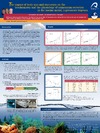Identificador persistente para citar o vincular este elemento:
https://accedacris.ulpgc.es/jspui/handle/10553/7221
| Campo DC | Valor | idioma |
|---|---|---|
| dc.contributor.author | Fernández-Urruzola, Igor | en_US |
| dc.contributor.author | Packard, Theodore T. | en_US |
| dc.contributor.author | Gómez, May | en_US |
| dc.date.accessioned | 2012-04-10T08:41:21Z | - |
| dc.date.accessioned | 2018-06-18T06:51:35Z | - |
| dc.date.available | 2012-04-10T08:41:21Z | - |
| dc.date.available | 2018-06-18T06:51:35Z | - |
| dc.date.issued | 2011 | en_US |
| dc.identifier.uri | https://accedacris.ulpgc.es/handle/10553/7221 | - |
| dc.description.abstract | Ammonium (NH4+) release by bacterial remineralization and heterotrophic grazers determines the regenerated fraction of phytoplankton productivity, so the measurement of NH4+ excretion in marine organisms is necessary to characterize both the magnitude and the efficiency of the nitrogen cycle. Glutamate dehydrogenase (GDH) is largely responsible for NH4+ formation in crustaceans and consequently should be useful in estimating NH4+ excretion by marine zooplankton.<br />Here, we address body size and starvation as sources of variability on the GDH to NH4+ excretion ratio (GDH/RNH4+). We found a strong correlation between the RNH4+ and the GDH activity (r2 = 0.87, n = 41) during growth. Since GDH activity maintained a linear relation (b = 0.93) and RNH4+ scaled exponentially (b =0.55) in well fed mysids, the GDH/RNH4+ ratio increased with size. However, the magnitude of its variation increased even more when adult mysids were starved. In this case, the GDH/RNH4+ ratio ranged from 11.23 to 102.41. | en_US |
| dc.language | eng | en_US |
| dc.source | 5th International Zooplankton Symposium, Pucón, Chile, Marzo, 2011 | en_US |
| dc.subject | 251001 Oceanografía biológica | en_US |
| dc.subject.other | Glutamate dehydrogenase | en_US |
| dc.subject.other | Ammonium excretion | en_US |
| dc.subject.other | Leptomysis lingvura | en_US |
| dc.subject.other | Starvation | en_US |
| dc.subject.other | Body size | en_US |
| dc.title | The impact of body size and starvation on the biochemistry and the physiology of ammonium excretion in the marine mysid, "Leptomysis lingvura" | en_US |
| dc.type | info:eu-repo/semantics/conferenceobject | en_US |
| dc.type | Conference poster | en_US |
| dc.identifier.absysnet | 659342 | - |
| dc.investigacion | Ciencias | en_US |
| dc.rights.accessrights | info:eu-repo/semantics/openAccess | es |
| dc.type2 | Póster de congresos | en_US |
| dc.utils.revision | Sí | en_US |
| dc.identifier.ulpgc | Sí | en_US |
| item.grantfulltext | open | - |
| item.fulltext | Con texto completo | - |
| crisitem.author.dept | GIR ECOAQUA: Ecofisiología de Organismos Marinos | - |
| crisitem.author.dept | IU de Investigación en Acuicultura Sostenible y Ec | - |
| crisitem.author.dept | GIR ECOAQUA: Ecofisiología de Organismos Marinos | - |
| crisitem.author.dept | IU de Investigación en Acuicultura Sostenible y Ec | - |
| crisitem.author.dept | Departamento de Biología | - |
| crisitem.author.orcid | 0000-0001-7287-3503 | - |
| crisitem.author.orcid | 0000-0002-5880-1199 | - |
| crisitem.author.orcid | 0000-0002-7396-6493 | - |
| crisitem.author.parentorg | IU de Investigación en Acuicultura Sostenible y Ec | - |
| crisitem.author.parentorg | IU de Investigación en Acuicultura Sostenible y Ec | - |
| crisitem.author.fullName | Fernández Urruzola, Igor | - |
| crisitem.author.fullName | Packard, Theodore Train | - |
| crisitem.author.fullName | Gómez Cabrera, María Milagrosa | - |
| Colección: | Póster de congreso | |
Visitas
41
actualizado el 27-ene-2024
Descargas
14
actualizado el 27-ene-2024
Google ScholarTM
Verifica
Comparte
Exporta metadatos
Este elemento está sujeto a una licencia Licencia Creative Commons

